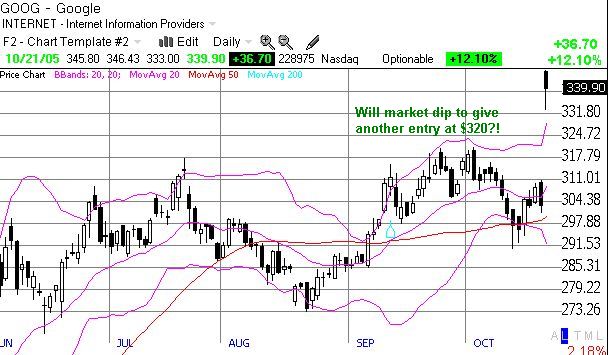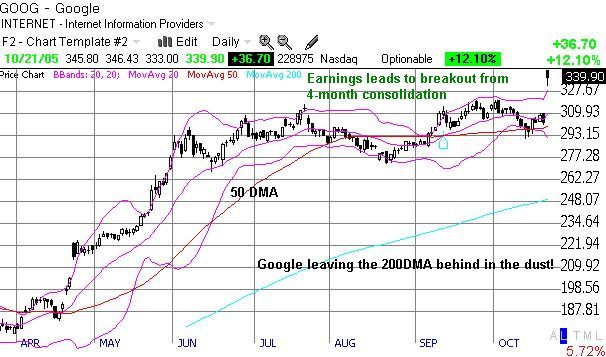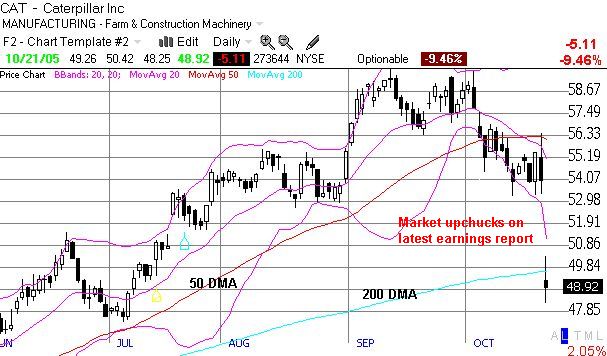The monster of
the Internet roars again. Google
"shocked" analysts on Thursday evening with earnings and revenue
growth that far surpassed expectations. I
am sure many have marveled at the transformation of Google from being another
signpost on the tortuous path through the bubble economy to becoming the digital
goliath spreading fear, dread, and reluctant admiration in more and more
sectors of the economy. You can see this
transformation even in my writings. In April, 2004, I wrote disparagingly about the
prospects of the imminent Google IPO.
I even predicted amongst friends and colleagues that Google would never
go higher than its initial IPO price.
The market yawned and forced Google to drop its initial offering
price. In short-order, Google became one
of few stocks that could keep up with the rampaging prices in the oil and gas
sector. My own transformation was
complete when I scoffed at all the
trigger-happy traders and analysts who scrambled to get out of the way as
Google talk about slower sales due to seasonal factors. Heck, I even thumbed my nose at the bears as
I urged folks to buy the dips because "a slow season precedes a strong
season." Finally, I chided the S&P for its
short-sightedness in passing over Google for homebuilder Lennar
(LEN) for inclusion in its much-followed S&P 500 index.
They now have three declining
homebuilder stocks in that index, and we can only
suppose that by the time Google gets the green light, the peak will either be
in or quickly approaching for GOOG stock. And, oh yeah, Trader Mike
finally bought into the bandwagon by including a Google position in his IRA
- I had to jab him on that one with tongue-in-cheek.
Now, I get a
good laugh at watching analysts scramble the jets to further hike price
targets on Google and to upgrade the stock.
I expect that most of the remaining analysts who have tried to hold onto
bearish opinions will soon be forced to join the party. For example, I read in Barron's this weekend
that Needham & Co have upped Google from Hold
to Buy and moved their price target from $300 to $370. This target is only 10% from current
levels. Something tells me they are
still being too conservative. Here is my
own attempt to provide a price target based on a relative comparison to the
prices folks are willing to pay for Yahoo's earnings. Please note that this logic got a lot of us
in trouble during the bubble days, so you must keep this analysis in the
proper perspective: as long as the market is willing to pay what it is paying
for Yahoo's performance, I am guessing that the market will mark up Google's price
to an equivalent valuation.
According to Yahoo!finance, the forward P/E of
YHOO and GOOG are roughly equal right now.
However, the PEG
ratio of GOOG is 1.82 and YHOO is about 2.10. To get equal to YHOO, this
means another 16% move from here or $396. Let's call it $400. And this target only goes higher the more
people are willing to pay for YHOO's performance.
Again, the key
to this analysis is that current valuation metrics and trends continue as they
are. For example, if you are bearish,
you could make a reverse argument and say that Google will be price down
to Yahoo's level. You could even find
some other low-value Internet stock to mark Google down to. I would call you wrong, but that is why we
have a marketplace for stocks. In other
words, I am not keen to scoff at even the most giddy
of analysts
who are calling for $450 price targets. After all, that is "only" 32% above current levels!
On the other
side of the economy, I have marveled at how slow the market has been to give
into the Fed.
We all know how long-term bond yields have remained stubbornly low
despite the Fed's persistent efforts to push them higher. We are not supposed to fight the Fed, but the
market's recalcitrance has meant that many stocks in traditionally interest
rate sensitive sectors, in other words "cyclicals",
have only just now begun to stumble and even tumble. I turn your attention to charts like the
housing sector, steel, financials, many industrials, and even utilities. Caterpiller (CAT) is
the latest victim. The last excitement
in the stock occurred at the beginning of October as traders bet that CAT would
sell more construction equipment to help reconstruction efforts in the
hurricane-worn Gulf
Coast region. CAT ran up a quick 10% on these bets. On Friday, CAT reported excellent year-over-year
results with earnings jumping 34% and revenues popping 17%. To keep up with growing global demand for
their equipment, CAT has hired 4300 additional production workers. This kind of growth has occurred even with the
Fed actively trying to cool the economy - another clear indicator of the Fed's
conundrum. Caterpillar also provided
generally positive earnings and revenue forecasts but the chinks in the armor
were lowered guidance for full 2005 earnings and an extremely wide range for projected
2006 earnings producing a bottom estimate a full 6.6% below the average analyst
forecast. CAT has rarely disappointed in
the past three years or so, so the market was quick to surmise that the end of
the party is nigh. CAT's
stock tumbled to levels typically indicative of the end of a party - a sharp,
painful gap down by almost 10% directly directly
below the 200 daily-moving average.
While the
contrast is now very sharp between stocks like GOOG and CAT, all is not well in
techland either. The Nasdaq
has been struggling lately and earnings news has been coming in mixed. For example, IBM provided us some reassurance
but Nokia disappointed. Many have
predicted a fourth quarter rally for tech stocks and the market in
general. The near-term headlines
probably cannot get worse than they look now, but the upside catalysts are also
hard to find. With the Fed expected to
bump rates up again on November 1st, the do-or-die moment for the
stock market is right around the corner.
My main question is which side of the economy will emerge the
survivor? Can we use Google to search
for answers?
Regardless, be careful out there!
© DrDuru, 2005



